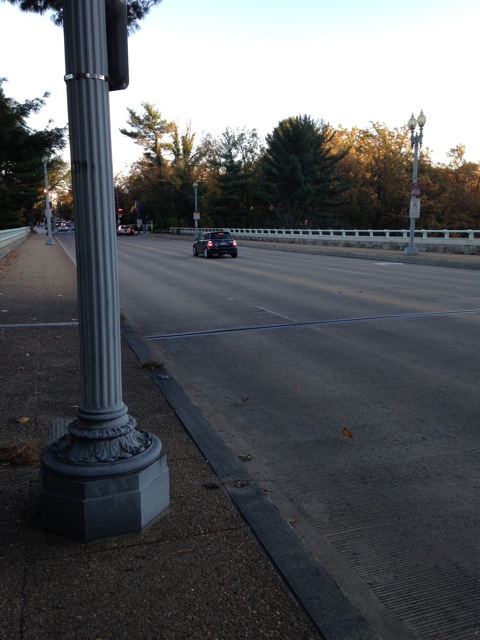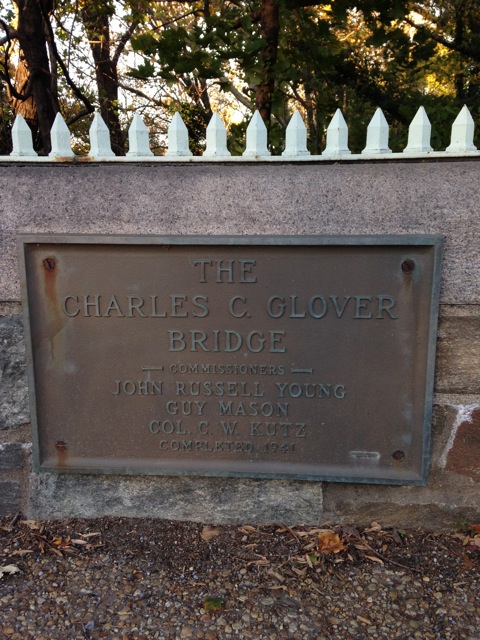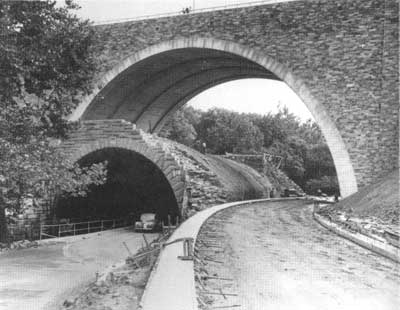- State:
- WASHINGTON-DC
- Site Type:
- Infrastructure and Utilities, Roads, Bridges, and Tunnels
- New Deal Agencies:
- District of Columbia Commissioners (DC only), Federal & Military Operations, Public Works Funding, Territories & Reservations, Army Corps of Engineers, Federal Works Agency (FWA), Bureau of Public Roads (BPR)
- Started:
- 1940
- Completed:
- 1941
- Designers:
- Harrington & Cortelyou - Engineers, Louis Justement - Architect
- Contractor:
- Potts and Callahan Company
- Quality of Information:
- Very Good
- Marked:
- Yes
- Site Survival:
- Extant
Description
The Massachusetts Avenue bridge was built in 1940-1941 by the Army Corps of Engineers with federal funds provided by Congress to the District of Columbia Commissioners. It was a final step in the completion of the Rock Creek and Potomac Parkway in the New Deal era. The new bridge replace a low earth-fill causeway over the creek, built in 1901, and a tunnel under the causeway that impeded traffic on the new Rock Creek parkway.
Congress appropriated $360,000 for the bridge under the District of Columbia act of 1939. Additional funding was added in 1941 to dynamite the old bridge and finish the 4-lane parkway beneath the new one. Funds for paving the new bridge came from the Public Roads Administration, a division of the Federal Works Agency (FWA), as part of a larger project to pave Massachusetts Avenue from Wisconsin Avenue to California Street (Post 1941).
The design of the Massachusetts Avenue bridge was meant to echo that of the earlier Connecticut Avenue bridge, built in the 1920s. As described by Ross (1992), “The design of the new bridge allowed the parkway to pass underneath its large arch, and it harmonized with the pre-existing bridges over Rock Creek. The same team of designers was responsible for this bridge as for the contemporary K Street Bridge.” That team included DC-based architect Louis Justement and the Kansas City engineering firm of Harrington & Cortelyou. Construction was carried out by Potts and Callahan Company.
The bridge is 420 feet long with a single-arch spanning 150 feet. It is 104 feet wide and 75 feet wide. The facade is a rough facing of multicolored gneiss. The only details are a smooth arch ring, simple parapet, and tubular steel safety railings (Ross 1992, p. 7).
In 1949, the bridge was renamed after Charles C. Glover, a long-time advocate of parks in the District of Columbia.
Source notes
"President signs D.C. supply bill for $47,255,155," Evening Star, April 5, 1938, p. B-1.
"Proposed bridge site," Sunday Star, March 19, 1939, p. A-19 photograph.
“$1,158,000 D.C. roads program set,” Washington Post, March 23, 1941, p. B1
"Dynamiting the old Rock Creek tunnel," Evening Star, August 11, 1941, p. B-1 photograph.
Amy Ross, Massachusetts Avenue Bridge (Charles C. Glover Bridge), HAER No. DC-22, 1992. Library of Congress Historic American Engineering Record
Site originally submitted by Anika Rice on November 16, 2014.
At this Location:
- Lauzun’s Legion (P Street) Bridge - Washington DC
- Rock Creek and Potomac Parkway Completion - Washington DC
- Duke Ellington (Calvert Street) Bridge - Washington DC
- Rock Creek and Potomac Parkway: Shoreham Hill Bridge - Washington DC
- Rock Creek and Potomac Parkway: Paths and Foot Bridges - Washington DC
View all sites at Rock Creek and Potomac Parkway - Washington DC (6 Sites)
Contribute to this Site
We welcome contributions of additional information on any New Deal site.
Submit More Information or Photographs for this New Deal Site





Join the Conversation